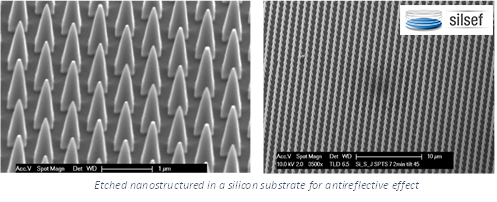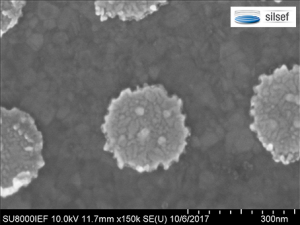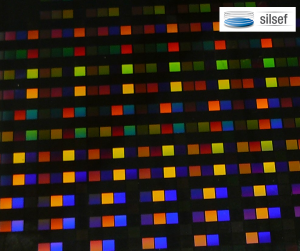Optics
SILSEF’s nanopatterning technologies are highly suitable for applications in the optics field. These micro-nano structures can be utilized in various ways, such as diffraction gratings for spectrometers, antireflective surfaces, plasmonic effects for biodetection, and light management. Our pattern catalog offers ready-to-use demonstrations of these principles, and we can further develop customized solutions for specific applications.
Antireflective treatment
At SILSEF, we create antireflective treatments by embedding nanostructures into a substrate or a thin film applied to its surface. These structures replicate the “moth-eye effect,” functioning as an adaptive index layer. This layer simulates a low optical index at the nanostructure tips, which gradually increases to match the substrate’s index.

This technology allows an effective anti-reflexion treatment on a wide spectral band and a large range of incident light angles. It can be applied on large surface, plane or curved and on a wide range of materials.

Plasmonic
There are two main types of plasmonic effects: localized and non-localized.
Non-localized plasmonic effects, such as Surface Plasmon Resonance (SPR), are commonly used in sensing applications. In this case, the resonance is caused by the interaction between incident light and a metallic surface with a periodic nanopattern. This interaction results in a broad absorption dip in the reflection spectrum at the resonance wavelength or coupling angle. These responses can be utilized in sensors to detect various species, such as gases or molecules.
On the other hand, localized plasmonic effects involve the enhancement of the electromagnetic field of incident light in a specific area. This localized enhancement can be used to improve optical coupling, as seen in Surface-Enhanced Raman Scattering (SERS) based sensors.


Diffraction
A diffraction grating is an optical element having the ability to diffract light by a periodic variation of its profile and / or its index (hologram). Diffraction gratings have the property of deflecting angularly a monochromatic beam as well as angularly separating the wavelengths of a polychromatic beam.
Diffraction gratings have interesting properties in order to “manipulate” light. It is possible to separate a monochromatic incident beam into several beams or to angularly separate the different wavelengths of a polychromatic source. It is also possible to play on different grating’s parameters such as the period, the material, the depth to obtain the desired diffraction intensity .

Light extraction
In nuclear detector, the high refractive index of the scintillator crystals causes a large number of the produced UV-vis photons to remain trapped inside the crystal : therefore up to the 70% of the light produced is not collected by the photodetector. Also, the spatial resolution and the sensitivity of existing systems suffer from this low photons collection efficiency.
SILSEF developed solutions with CERN :
- Light extracting layers can be deposited/fabricated on the exit surface of the scintillator crystal in order to increase the number of photons extracted.
- A possible light extraction layer is a nano-patterned thin film of a material with refractive index higher than the scintillator (n > 1,8) for LYSO : this diffraction grating is referred to as ‘photonic crystal’ (PhC).